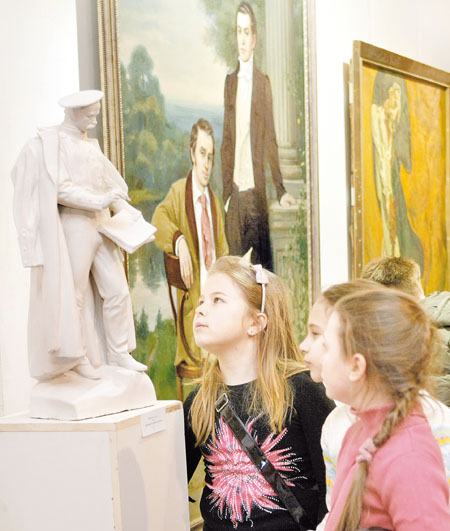Painting Shevchenko
This year’s Historical Painting Biennale dedicated to Kobzar’s birth anniversary
Last Friday Kyiv’s Central House of the Artist saw the opening of the sixth Historical Painting Biennale, “Ukraine from Trypillia to the Present Day,” dedicated to the 200th birth anniversary of Taras Shevchenko.
The Historical Painting Biennale has been held every two years since 2004 under the auspices of the National League of Ukrainian Artists. The event’s curator is the League’s member Oleksandr Melnyk. This exhibit has a somewhat unusual goal – to visualize the images of our history and thus fill gaps in Ukrainian historical painting. “Some may reproach us that it is an outmoded idea for art and that Europe passed this stage in the 19th and 20th centuries,” says Oles SOLOVEI, an artist and the biennale’s executive secretary. “But Ukraine was part of the Russian and then Soviet empire at the time. We had superb artists, but the era dictated themes and emphases to them. So it is important that artists should look back today on certain historical topics and project the visible images of our past.”
Every time, participants are offered a certain pressing topic (for example, in 2012 the biennale was dedicated to the 1,160th anniversary of the time Kyivan Rus’ was first mentioned in a chronicle), but the displayed artworks are not confined to it only because the time span – from Trypillia to the present day – provides unlimited opportunities for reconsidering history.
This time, too, according to Solovei, about a quarter of the works are on the life and oeuvre of Taras Shevchenko. They differ in genres and in the depth of assessing the Kobzar’s figure. There are a lot of illustrations to his poems as well as Cossack motifs. Yet there are also some interesting interpretations. Will it be possible to update Shevchenko and discover him from an unexpected side? The curators answer this question in the affirmative, but every spectator will draw his or her own conclusions.
“So many generations may have been pursuing the Shevchenko theme, but everyone is still finding something new for themselves and for us,” Oleksandr MELNYK shares his impressions and singles out the Kharkiv-based artist Oleh Omelchenko’s work Taras’s Prophecy. Mr. Melnyk himself is displaying the picture Road to Eternity which he finished exactly a week before the biennale. It depicts the reburial of Shevchenko in Kaniv according to an old tradition when the coffin with an unmarried man was carried by girls.
“Shevchenko is undoubtedly a complex personality. Working on the picture Taras’s Prophecy, I tried to read as many materials about him as possible,” Oleh OMELCHENKO, an exhibit participant and an instructor at the Kharkiv Academy of Design and Arts, says. “The poet has several works based on Biblical prophecies. One of them is about the revival of Ukraine. I tried to express this work in an allegorical form by drawing sort of a tree of life surrounded by Taras’s heroes. Here is the family, the Cossacks, and the Haidamaky uprising, i.e., the masculine aspect of the Ukrainian soul which embodies a force aimed at protecting national integrity and the feminine aspect which symbolizes beauty. So love and courage, as well as folk poetry, nourished the oeuvre of Shevchenko. While, before I began to paint the picture, I was taking a more skeptical attitude to the Kobzar, his personality was more and more absorbing me as I was delving deep into his poetry. Naturally, Shevchenko does not need to be idolized. He was quite a down-to-earth person, but, at the same tine, he was a real genius, a prophet, one of the Ukrainian nation’s pillars. Everybody is now aware, so to speak, of the portentousness of the moment, for the biennale is held against the backdrop of the anniversary and the Maidan.”
As for the latter, you cannot help noticing so many calls for freedom on the displayed canvases. But, unfortunately, these calls come from previous historical realities. “There is a real popular demand for and a desire to learn the experience of Shevchenko not because of his anniversary but because we are now in a situation that was very familiar to him – in a situation when the crucial question is what is Ukraine and what it means to be Ukrainian. Moreover, we must answer it not only to ourselves, but also to the world community. In this context, the exhibited images and subjects have fallen hostage to the past,” art critic Oleh ZABAVA comments on the biennale.
The 6th Historical Painting Biennale will last until February 2. Admission is free.






